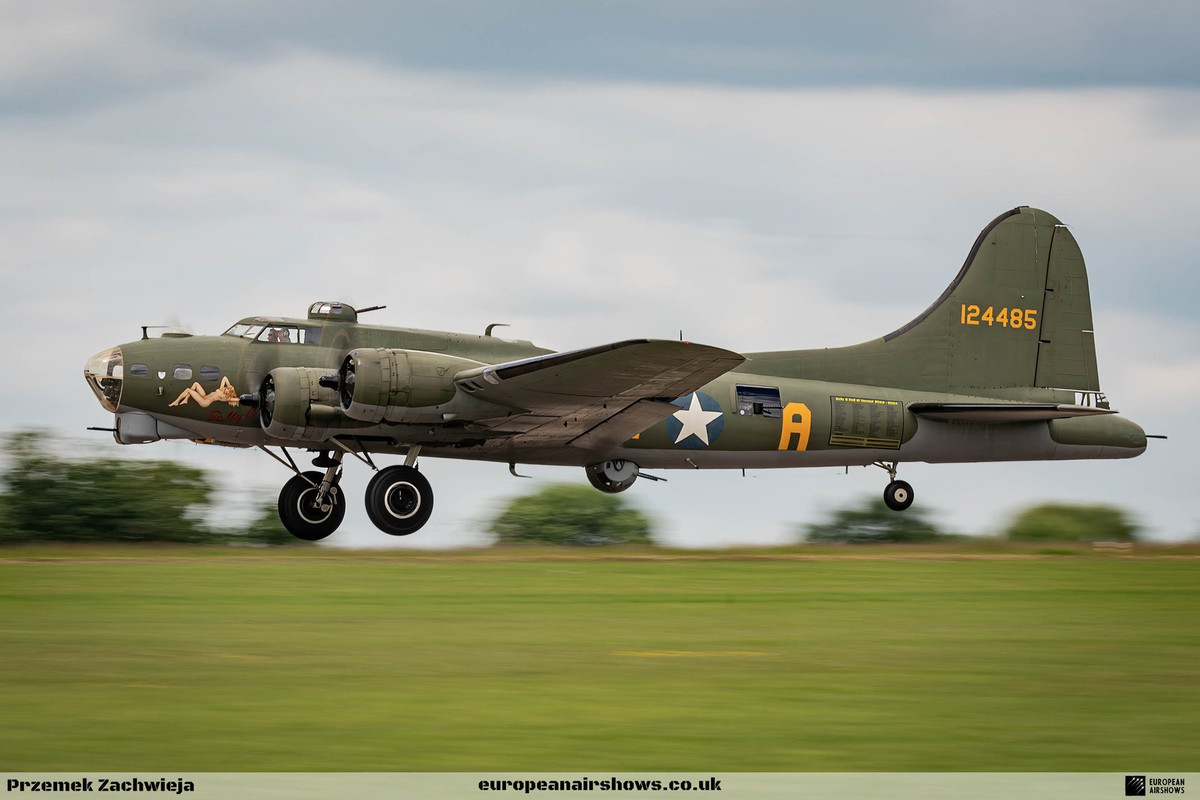
Boeing B-17G Flying Fortress G-BEDF
About the Boeing B-17 Flying Fortress
The Boeing B-17 Flying Fortress isn’t just an airplane—it’s a legend with wings, a beast of the skies that roared through World War II with grit and guts. Picture this: a four-engine bomber bristling with machine guns, shrugging off flak like a champ, and still making it home with half its tail shot off. Born in the 1930s from Boeing’s ambitious vision, the B-17 was built to pound enemy targets from miles above the earth, a flying fortress indeed—earning its name with up to 13 guns blazing. It flew into history over Europe, dropping more bombs than any other U.S. aircraft in the war, and became a symbol of American air power that’s still awe-inspiring today.
The B-17’s story starts in 1934, when the U.S. Army Air Corps decided it needed a bomber that could hit hard and fly far. Boeing’s answer was the Model 299, a sleek beast that first took flight in 1935, dazzling onlookers with its speed and size. Sure, the prototype crashed in a fiery mess, but that didn’t stop the Army from ordering a fleet. By the time World War II kicked off, the B-17 was ready to rumble, evolving through models until the G variant stole the show. Over 12,700 were built, and they dropped a jaw-dropping 640,000 tons of bombs on Axis targets—talk about leaving a mark!
What made the B-17 a rockstar wasn’t just its bomb bay—it was its toughness. Crews loved it because it could take a beating and keep flying. Picture a plane limping back from Germany with engines out, wings riddled with holes, and still landing safely—that’s the B-17 magic. It wasn’t all glamour, though; those daylight raids were brutal, with crews braving freezing altitudes and swarms of enemy fighters. After the war, these warbirds didn’t just retire—they took on gigs like firefighting, cargo hauling, and even starring in movies, proving they had staying power beyond the battlefield.
Specifications
Crew
10
Length
74 ft 4 in (22.66 m)
Wingspan
103 ft 9 in (31.62 m)
Height
19 ft 1 in (5.82 m)
Max Speed
287 mph (462 km/h, 249 kn)
Range
2,000 mi (3,219 km, 1,738 nmi)
Service Ceiling
35,600 ft (10,850 m)
Rate of climb
900 ft/min (4.6 m/s)
B-17G Variant
The B-17G Flying Fortress wasn’t just another bomber—it was the ultimate evolution of a wartime icon, hitting the skies in 1943 with swagger and steel. This variant took everything the earlier models learned in battle and cranked it up a notch, starting with a shiny new chin turret packing two .50 caliber machine guns. That addition was a game-changer, plugging a nasty gap in the B-17’s defenses against head-on attacks from German fighters. With a total of 13 guns, the G model turned into a flying porcupine, ready to fend off anything the Luftwaffe threw its way.
Compared to its siblings like the B-17F, the G brought some serious upgrades to the party. The tail gunner got a better perch with improved visibility and firing range, while the waist gunners traded open windows for enclosed positions—because who doesn’t want a little shelter at 25,000 feet where it’s colder than a polar bear’s toenails? Extra armor and self-sealing fuel tanks made it tougher, too, letting it shrug off hits that would’ve sent earlier models spiraling. Powered by four Wright R-1820-97 engines churning out 1,200 horsepower each, the B-17G could lug up to 17,600 pounds of bombs on short hops, though it usually carried around 8,000 pounds for those long hauls over Europe.
Over 8,600 B-17Gs rolled off the lines, making it the most common Flying Fortress variant—and for good reason. It flew high-altitude precision raids that hammered Nazi factories and cities, turning the tide in the daylight bombing campaign. Sure, the B-17E had introduced the tail gun and the F refined the formula, but the G perfected it with those combat-driven tweaks. It wasn’t just about surviving—it was about hitting back hard, proving that this variant was the king of the B-17 family and a cornerstone of Allied air power.
Did You Know?
- The B-17 Flying Fortress dropped more bombs than any other U.S. aircraft in World War II—over 640,000 tons—making it the heavyweight champ of the air war.
- One B-17, dubbed "All American," made it back to base after a mid-air collision sliced its tail nearly in half, proving these beasts could take a licking and keep on ticking.
- The B-17G’s chin turret was added after pilots begged for better defense against frontal attacks—those two extra guns turned it into a nightmare for enemy fighters.
- Over 50 B-17s completed 100 missions or more, but crews nicknamed them "Hangar Queens" if they spent more time being repaired than flying.
- A B-17 once landed itself—sort of! In 1944, a damaged Fortress touched down pilotless after its crew bailed out, thanks to its sturdy autopilot and a lot of luck.
Test Your Knowledge
1. What was the primary role of the B-17 Flying Fortress?
B-17G Flying Fortress G-BEDF 'Sally B'
Sally B, a gleaming new B-17G Flying Fortress, missed the war by a whisker, rolling into service with the United States Army Air Forces on June 19, 1945, as serial number 44-85784. Too late to tangle with enemy fighters over Europe, this particular bomber swapped combat for a quieter life, first morphing into a TB-17G to train eager pilots, then into an EB-17G to test cutting-edge gear. By 1954, it ditched the military scene entirely, heading to France to join the Institut Géographique National. There, it spent two decades crisscrossing the skies, mapping the world below—a far cry from the bomb-dropping destiny its designers had in mind.
In 1975, Sally B packed its bags—or rather, its wings—and jetted across the Channel to England, landing at Duxford under the care of Ted White and Don Bullock. Registered as G-BEDF, it underwent a loving restoration to recapture its wartime swagger. This B-17G got its big break in 1990, starring in the film Memphis Belle, where it briefly masqueraded as a B-17F, complete with a temporary makeover. Afterward, it kept half of that Hollywood livery as a memento, while the other side flaunted its own Sally B nose art and a nod to Ted White on the starboard inner engine cowling. It’s a plane with a split personality, proudly showing off both its cinematic cameo and its unique identity.
What sets Sally B apart as a B-17G is its beefed-up design, the final evolution of the Flying Fortress family. This model came loaded with thirteen .50 caliber machine guns, including a standout feature: the chin turret. That remotely-operated beast was slapped on to fend off head-on attacks from German fighters—a lesson learned the hard way by earlier models. The waist gun positions got a clever tweak too, staggered to give gunners more elbow room and a better shot at the enemy. Though Sally B never saw combat, its bones carry the scars of wartime ingenuity, a testament to the relentless push to make these bombers tougher and deadlier.
Since 1985, Sally B has been the pride of B-17 Preservation Ltd, kept aloft by a crew of volunteers who treat it like a living legend. It’s not just a relic—it’s a flying salute to the USAAF airmen who braved the skies in these metal giants during World War II. You can catch it buzzing over airshows and memorials across the UK and Europe, with its annual flypast at the American Military Cemetery in Cambridge stealing the show. It’s a sight that blends nostalgia with awe, a reminder of the grit and glory packed into every rivet of this B-17G.
Keeping Sally B airborne is no picnic—it’s a full-on mission of love, skill, and cold hard cash. A team of dedicated volunteers, from grease-stained engineers to sharp-eyed pilots, pours their hearts into maintaining this beast, while the B-17 Charitable Trust hustles to fund its flights. Every takeoff is a triumph, a chance to share the saga of the Flying Fortress with anyone who’ll listen. Sally B isn’t just a plane; it’s a time machine, whisking us back to an era of courage and innovation, all wrapped up in the unmistakable roar of its four engines.

































